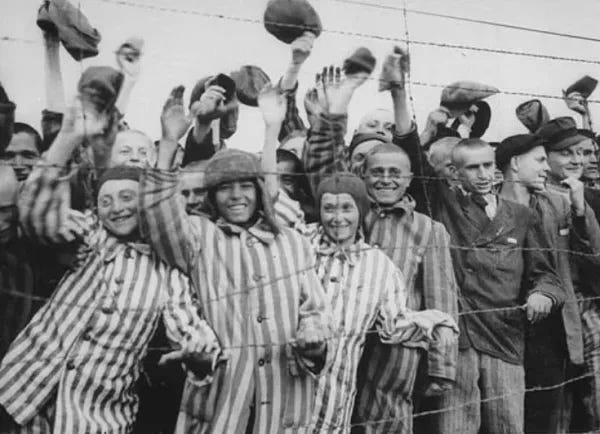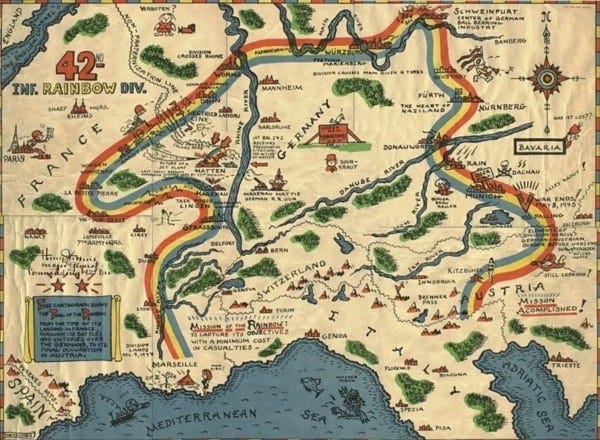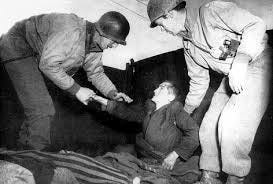I remember what my father had told me of his involvement in the liberation of Dachau shortly before he died in 1976.
Some of his war buddies discovered the tribute site I’d created for him and called or emailed me to recount stories I’d not known previously, or only in part.
In 2001, before HBO premiered its miniseries Band of Brothers, it requested historical background for its website to introduce each episode. My father’s story was featured on their website to introduce Episode 9, “Why We Fight,” which recounts the liberation by “Easy Company” of one of the Dachau sub-camps.
Over the two decades since, scores of people have contacted me:
The son of a liberated inmate had seen the pictures on the site, pictured above, and identified his father, Stephen Ross (Rozenthal) — 14 at the time, an orphan from Poland who had survived ten concentration camps in five years — as
“the first striped pajama in the left foreground… your Dad saved my Dad’s life.”
An 89-year-old former inmate emailed me saying,
“Yes, for me it will always be The American Army who did it.”
They’re almost all gone now, but not forgotten.
On April 29, 1945, three divisions of the U.S. Army liberated the Dachau Concentration Camp outside Munich, Germany. My father, Staff Sergeant John Petro, was one of the liberators with the 42nd “Rainbow” Infantry Division, specifically with the 232nd Infantry. I have told his story elsewhere. Here is the historical background.
The 42nd Rainbow Infantry Division at Dachau
Major Douglas MacArthur named the “Rainbow” Division in World War I when National Guard units from 26 states and the District of Columbia were combined into a single group. When he saw all the colorful state flags, he said it “was like a rainbow” across the country. The name stuck.
During World War II, the Rainbow transport landed on a cold and rainy night at the port of Marseille, France, on December 8 and 9, 1944; they pitched their tents there. They moved north through Lyon and Dijon, arriving shortly before Christmas near Strasbourg.
The Rainbow turned back the final German offensive, codenamed Operation Northwind, in the Alsace area. It crossed the Maginot Line, breached the Siegfried Line, crossed the Rhine River on March 31 at Remagen, and advanced through Würzburg and Schweinfurt in hard-fought battles.
Then the Rainbow moved through Furth and Donauworth, where it crossed the Danube River and headed south to Munich for what was expected to be the Nazi‘s last stand, as it had initially been the party’s birthplace in the ’30s.
Dachau, 1st of the Nazi Concentration Camps

Eight decades have gone by since the Nazi concentration camps were exposed to the world, and the world has been confronted with images of unimaginable horror.
Those images have been associated with the names Dachau, Auschwitz, and Buchenwald. We remember them on Holocaust Remembrance Day.
But Dachau was special.
Unlike Auschwitz, a death camp, an extermination camp intended to put its inmates to death via a gas chamber, Dachau was created as a forced labor camp.
Dachau was:
the first
the prototype
the SS training camp
the largest
the oldest
the most notorious
the worst
The Konzentrazionslager (KZ) Dachau had three hundred sub-camps called Kommandos and Auskommandos, controlling about 67,000 prisoners dedicated to supplying workers for munition factories, repair shops, and producing products like shoe polish, delicate porcelain, clothing, and other war matériel.
In the process, tens of thousands were shot, beaten, tortured, and starved to death. Many thousands also died of typhus and disease. Inmates were used as guinea pigs in medical experiments “for the benefit of mankind” by exposing them to water and extreme cold. This was intended to test the hypothetical survivability of pilots shot down over the ocean.
In the overall total, at the peak of the Dachau camps’ population, there were 22,000 Jews and various Germans, Gypsies (Romani), Serbs, Croats, Slovenes, Poles, and Czechs… and one known American.
Dachau’s Origins
Immediately after Adolf Hitler became Chancellor of Germany and the Nazi Party was given control over the police, Heinrich Himmler, Commissioner of Police for the City of Munich, established KZ Dachau on March 22, 1933, to accommodate 5,000 people. He asserted:
“…We have adopted this measure, undeterred by paltry scruples, in the conviction that our actions will restore calm in our country, and is in the best interest of our people.”
Originally intended to be a camp for political prisoners, it became:
“…a factory designed to wear out, destroy and consume prisoners entrusted to its gates; and the sadistic philosophy and background of the whole camp is summarized in the words over the gate of the concentration camp: ‘Albeit Macht Frei’ — the translation of which is — ‘In Work You Will Be Free’ “
– General Henning Linden, Assistant Commander, 42nd Infantry Division, Memorandum to the Commanding General. Report on Surrender of Dachau Concentration Camp
Built by forced labor under the direction of the SS (Schutzstaffel), Dachau was used as a training center for SS guards who would be assigned to other camps. Dachau became the model for these camps.
Two years later, the original ostensible purpose was modified. In 1935, the Nazi Nuremberg Laws allowed for racial discrimination based on the Nazi policy of “protection of German blood and honor.” No longer just for political prisoners, Dachau now housed those considered by the Nazi party to be “undesirable and asocial elements”: Jews, Jehovah’s Witnesses, pacifists, Gypsies, emigrants, homosexuals, clergy, prostitutes, the mentally ill. Each group wore a “badge of shame” in different shapes and colors.
In Himmler’s final command, 12 years and 24 days later, he ordered the camp’s destruction. But he was too late.
Located hardly a mile and a half from the comfortable, genial town of Dachau, this concentration camp was one of the last in operation under the National Socialist dictatorship.
Dachau Death Train
When the Rainbow Division moved into the camp, they first noticed the railroad track. It had been used to move large numbers of prisoners in and out of the camp.
When the Rainbow arrived, there was a line of about 50 boxcars, the last transport from the Buchenwald and Kaufering camps ahead of the advancing Russian army. But there was no room for them at Dachau. The SS troops were struck with terror at the Americans’ approach, so the prisoners were forced to remain in the cars until they died.
As each car was opened at Dachau, it revealed about 30 bodies, some naked, some in rags, barefoot, or with makeshift wooden shoes. It did not smell, evidence that they had all died very recently. Bodies were piled three and four high in the cars.
“Thousands of them, half-clothed in rags — dead.” Some showed signs of beatings, “except for a small percentage [who] were shot, they died from starvation and exposure, and having been on the train twenty-seven days without food… All were mere skeletons, weighing on the average of 50 or 60 pounds.” –Lieutenant Colonel Walter J. (Mickey) Fellenz, Commanding Officer, 1st Battalion, 222nd Regiment.
Twenty-four-year-old Tony Cardinale, HQ Company, 222nd Regiment, detected a movement amidst all the bodies. It was a hand waving weakly back and forth between bodies on top of it. He called to Colonel Downard, Commanding Officer of the 2nd Battalion.
“Hey, Colonel! Here’s a live one!”
The Colonel ran back, climbed into the train car, lifted the prisoner out of the pile of bodies, and handed him down to Tony and his Sergeant. In wide-eyed bewilderment, the Polish prisoner asked Tony,
“Frei..? Frei…?”
In his inadequate German, Tony tried to tell him that, yes, he was now “free” and in good hands. The Colonel placed the man in his own jeep to take him to the U.S. Aid Station. They encountered some gunfire along the way, and the jeep cracked up.
Colonel Downward found himself lying on a litter next to the prisoner at the Aid Station, where they were both OK. In the confusion, no one learned the name of the sole survivor among the nearly 2,000 people on the train.
Continued tomorrow in Part 2.
Bill Petro, your friendly neighborhood historian
billpetro.com
I’m indebted to the stories of the other men of the Rainbow Division recounted in the book “Dachau 29 April 1945 The Rainbow Liberation Memoirs,” edited by Sam Dann. Other books on Dachau have been based on my father’s story at billpetro.com/johnpetro
Subscribe to have future articles delivered to your email. If you enjoyed this article, please consider leaving a comment.







